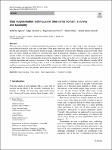Item Infomation
Full metadata record
| DC Field | Value | Language |
|---|---|---|
| dc.contributor.author | Guillermo, Iglesias | - |
| dc.contributor.author | Edgar, Talavera | - |
| dc.contributor.author | Ángel, González-Prieto | - |
| dc.date.accessioned | 2023-04-26T03:05:16Z | - |
| dc.date.available | 2023-04-26T03:05:16Z | - |
| dc.date.issued | 2023 | - |
| dc.identifier.uri | https://link.springer.com/article/10.1007/s00521-023-08459-3 | - |
| dc.identifier.uri | https://dlib.phenikaa-uni.edu.vn/handle/PNK/8319 | - |
| dc.description | CC BY | vi |
| dc.description.abstract | With the latest advances in deep learning-based generative models, it has not taken long to take advantage of their remarkable performance in the area of time series. Deep neural networks used to work with time series heavily depend on the size and consistency of the datasets used in training. These features are not usually abundant in the real world, where they are usually limited and often have constraints that must be guaranteed. Therefore, an effective way to increase the amount of data is by using data augmentation techniques, either by adding noise or permutations and by generating new synthetic data. | vi |
| dc.language.iso | en | vi |
| dc.publisher | Springer | vi |
| dc.subject | Data Augmentation techniques | vi |
| dc.title | Data Augmentation techniques in time series domain: a survey and taxonomy | vi |
| dc.type | Book | vi |
| Appears in Collections | ||
| OER - Công nghệ thông tin | ||
Files in This Item:

